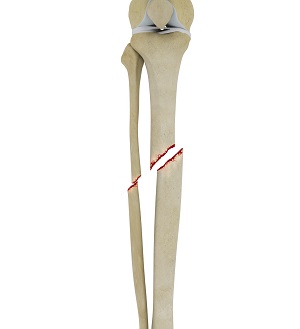
What is a Tibial Shaft Fracture?
A tibial shaft fracture is a crack or break in the middle section of the tibia bone due to severe trauma.
The lower leg is made up of two long bones called the tibia and fibula that extend between the knee and ankle and help form the ankle joint and knee joint. The tibia or shinbone is the larger of the two bones and is one of the major bones of the lower leg. It bears most of the body’s weight and plays a crucial role in balancing body weight when standing and walking. The tibia is the most frequently fractured long bone of the body. It normally takes a great amount of force for a fracture of the tibia to occur.
Types of Tibial Shaft Fracture
The types of tibial shaft fracture greatly vary based on the force that causes the fracture. Some of the types of tibial shaft fracture include:
- Transverse fracture: In this fracture, the break is a straight, horizontal line going across the tibial shaft.
- Oblique fracture: In this type, the break is noted as an angled line across the tibial shaft.
- Spiral fracture: A type of fracture caused by a twisting force in which the fracture line encircles the tibial shaft.
- Comminuted fracture: A severe type of fracture where the tibial shaft breaks into 3 or more pieces.
- Open fracture: This is also known as compound fracture and causes serious damage to the surrounding soft tissue structures as the tibial shaft fragments stick out through the skin to the external air exposing the fracture site.
Causes of Tibial Shaft Fracture
Some of the causes of tibial shaft fracture include:
- Osteoporosis
- Motor vehicle accidents
- Fall from heights
- Twisting force
- Sports injury
- Gunshot wounds
Signs and Symptoms of Tibial Shaft Fracture
Some of the signs and symptoms of tibial fracture include:
- Inability to bear the weight
- Severe pain
- Instability
- Difficulty in walking
- Deformity in the leg
- Swelling/bruising
- Numbness or tingling
Diagnosis of Tibial Shaft Fracture
To diagnose a tibial shaft fracture, your doctor will review your symptoms and medical history and conduct a thorough physical examination to look for signs of swelling, bruises, rupture of the skin, instability, and other deformities. In order to obtain further confirmation on the severity of the fracture, your doctor may recommend:
- X-rays: This study uses high electromagnetic energy beams to produce images of the bones and help to detect whether the tibia is intact or broken and the type of fracture and its location.
- CT scan: Uses special x-rays that produce images of the cross-section of your limb with clear images of any damages present that is not visible in an x-ray. It provides your doctor with crucial information about the severity of the fracture.
- Bone scan: This is a nuclear imaging study that helps your doctor to detect hidden stress fractures or any bone disorders such as avascular necrosis, arthritis, bone infection, or Paget’s disease of the bone.
Treatment for Tibial Shaft Fracture
Treatment for tibial shaft fracture depends upon the severity of the fracture and involves both nonsurgical and surgical methods. These include:
Non-surgical method
Surgical method
- External fixation: This method is performed in case you have multiple injuries. Your doctor will place metal screws and pins inside the bone which will be attached to a rod present outside the skin. This helps in stabilizing the bones during severe injuries or soft tissue injury.
- Intramedullary nailing: Your doctor will make a small incision near the knee and ankle, then a rod will be passed along the broken bone and intramedullary nails made of titanium will be fixed above and below the tibial shaft to stabilize and heal it.
- Plates and screws: In this procedure, your doctor will reposition the fragmented bones and align them by fixing it with screws and metal plates. The plates and screws method is employed when intramedullary nailing is not a viable option.
Recovery post-surgery may take anywhere from 4 to 6 months and varies from individual to individual depending on the severity of the tibial shaft fracture.










